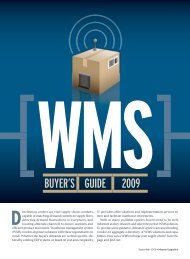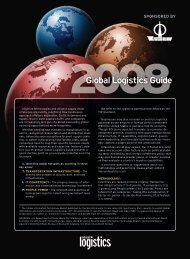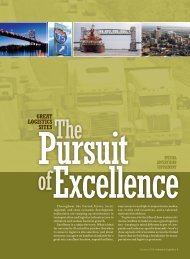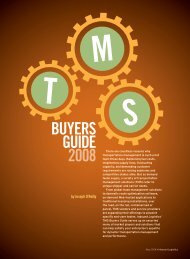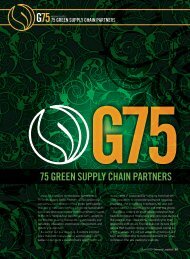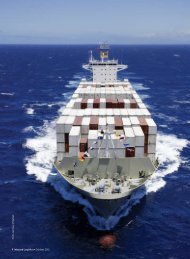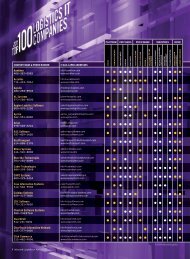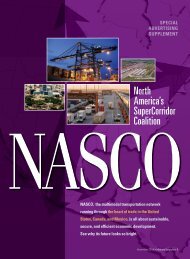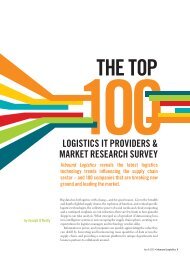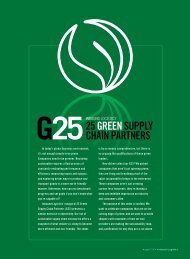Top 50 Green Supply Chain Partners - Inbound Logistics
Top 50 Green Supply Chain Partners - Inbound Logistics
Top 50 Green Supply Chain Partners - Inbound Logistics
You also want an ePaper? Increase the reach of your titles
YUMPU automatically turns print PDFs into web optimized ePapers that Google loves.
From 3PLs to motor freight<br />
carriers, <strong>Inbound</strong> <strong>Logistics</strong><br />
salutes supply chain<br />
visionaries who are leading<br />
the green revolution.<br />
G<strong>50</strong><br />
INBOUND LOGISTICS<br />
<strong>50</strong> GREEN SUPPLY<br />
CHAIN PARTNERS<br />
3PLs 2<br />
Air Cargo Carriers 8<br />
Expedited Carriers 10<br />
Materials Handling 12<br />
Ocean Carriers 12<br />
Ports 14<br />
Rail Carriers 16<br />
Truckers 18<br />
June 2010 • <strong>Inbound</strong> <strong>Logistics</strong> 1
GREEN<br />
SUPPLY CHAIN<br />
PARTNER<br />
2 0 1 0<br />
INBOUND LOGISTICS<br />
<strong>50</strong> GREEN SUPPLY CHAIN PARTNERS<br />
3PLs<br />
AEP River Operations<br />
GREEN URL: http://tinyurl.com/35rl78t<br />
Recycling is a large part of how AEP River<br />
Operations manages its waste. The company<br />
initiated a program called SEE GREEN in October<br />
2008 to reduce waste from its barge operations.<br />
In 2009, AEP recycled approximately 3,<strong>50</strong>0 cubic<br />
yards of waste, as well as 70,000 pounds of<br />
vessel mooring lines. In addition, the company<br />
recycles 90 percent of all onboard waste, cutting<br />
disposal costs in half and reducing the risk of<br />
harming the environment.<br />
Electronic waste recycling | ATCLE<br />
ATC <strong>Logistics</strong> &<br />
Electronics<br />
GREEN URL: http://tinyurl.com/36szupm<br />
ATCLE has established a dedicated green team<br />
with cross-functional participants who gather<br />
monthly to identify opportunities to improve the<br />
environment, as a company and within specific<br />
departments. Through a top-down organizational<br />
commitment to reducing negative environmental<br />
impact in internal operations, the 3PL realized<br />
dramatic tangible benefits, cutting its overall<br />
environmental impact by approximately 10<br />
percent from 2007 to 2008.<br />
C.H. Robinson Worldwide<br />
GREEN URL: http://tinyurl.com/2flgs8a<br />
C.H. Robinson works with non-profit organization Cascade Sierra Solutions<br />
(CSS) to help motor carriers reduce fuel consumption and carbon emissions.<br />
To support CSS in its mission, the 3PL provides financial backing and<br />
helps promote CSS services to its network of more than 45,000 contract<br />
motor carriers in North America. Additionally, C.H. Robinson has invited<br />
its customers to participate in the newly developed C.H. Robinson-CSS<br />
Customer Match Program, which matches a percentage of C.H. Robinson’s<br />
eligible customers’ donations to CSS.<br />
DB Schenker<br />
GREEN URL: http://tinyurl.com/292s9ku<br />
DB Schenker’s <strong>Green</strong> <strong>Logistics</strong> Network project evaluates transportation<br />
modes not only according to economical aspects, but also from an<br />
ecological point of view. Under the umbrella of this initiative, the company<br />
offers shippers a carbon-optimized transport chain. The aim is to reduce<br />
carbon emissions through an intelligent shift to less carbon-intensive<br />
transportation modes and by offering alternative transport services. This<br />
helps to increase the share of low-emission modes in the transport chain<br />
and to reduce the carbon footprint for both shippers and for DB Schenker.<br />
Carbon-optimized transport, Hong Kong | DB Schenker<br />
Solar-powered warehouse, Martinengo, Italy | CEVA <strong>Logistics</strong><br />
CEVA <strong>Logistics</strong><br />
GREEN URL: http://tinyurl.com/29qgqlw<br />
Working in partnership with Starbucks and Smith Electric Vehicles, CEVA<br />
introduced high-performance zero-emission electric vehicles that make<br />
daily deliveries to Starbucks stores in London. The 3PL also operates ecosustainable<br />
facilities, such as a warehouse in Martinengo, Italy, fitted with<br />
more than 5,300 photovoltaic panels.<br />
2 <strong>Inbound</strong> <strong>Logistics</strong> • June 2010
CRST DEDICATED SERVICES | CRST VAN EXPEDITED | CRST MALONE | CRST CAPACITY SOLUTIONS | CRST LOGISTICS<br />
WE KEEP ROLLING AT A STRONG, STEADY PACE.<br />
55 years after the fi rst CRST truck carried its load, we’re carrying on stronger than ever. With our Van Expedited, Malone fl atbed, <strong>Logistics</strong>,<br />
Dedicated Services and Capacity Solutions divisions, we have the fl eet, manpower and technology to deliver any load. We’ve learned a lot about<br />
what it takes to succeed in our fi rst 55 years. Most importantly, that putting the needs of our<br />
customers fi rst will take us a very long way. It’s why so many companies rely on CRST International<br />
for all of their transportation needs.<br />
crst.com • 1-800-736-2778<br />
C R S T T H E T R A N S P O R T A T I O N S O L U T I O N
GREEN<br />
SUPPLY CHAIN<br />
PARTNER<br />
2 0 1 0<br />
INBOUND LOGISTICS<br />
<strong>50</strong> GREEN SUPPLY CHAIN PARTNERS<br />
3PLs<br />
DSC <strong>Logistics</strong><br />
GREEN URL: http://tinyurl.com/2gyfgf3<br />
During the fourth quarter of 2009, DSC <strong>Logistics</strong><br />
launched a new bill of lading (BOL) system<br />
throughout its network. The initiative came about<br />
after employees noticed the typical six-part BOL<br />
was often unnecessary. Working with suppliers to<br />
arrange for order forms with only the number of<br />
pages its logistics centers need, DSC expects to<br />
save 644,000 pages of paper each year.<br />
EA <strong>Logistics</strong><br />
GREEN URL: http://tinyurl.com/37uelbe<br />
Delivered GrEAn is EA <strong>Logistics</strong>’s corporate<br />
commitment to the environment. The forwarder’s<br />
sustainability mission includes computing carbon<br />
footprints for customers and providing free<br />
reforestation offsets to neutralize emissions;<br />
using biodiesel in its truck fleet and encouraging<br />
vendors to use it as well; enforcing no-idling<br />
restrictions at its facility; and requiring drivers<br />
to comply with drive speed rules to reduce fuel<br />
consumption.<br />
GENCO <strong>Supply</strong><br />
<strong>Chain</strong> Solutions<br />
GREEN URL: http://tinyurl.com/2fmot9v<br />
GENCO recently purchased 25 hydrogen fuel<br />
cell power units for use in lift trucks at a<br />
4<strong>50</strong>,000-square-foot dedicated distribution<br />
center. This sustainable solution eliminates the<br />
demand for and cost of electricity, significantly<br />
reduces greenhouse gas emissions, and removes<br />
toxic lead-acid from the workplace, replacing<br />
it with hydrogen, which generates water as a<br />
by-product. GENCO’s commitment to reverse<br />
logistics and supply chain sustainability includes<br />
returning serviceable goods to market through<br />
GENCO Marketplace, a product liquidation<br />
service that pushes unwanted, repaired, and<br />
refurbished merchandise back into the sales<br />
cycle, eliminating waste and generating new<br />
revenue streams.<br />
Low-emissions vehicle | J.B. Hunt<br />
J.B. Hunt<br />
GREEN URL: http://tinyurl.com/2fzujrl<br />
J.B. Hunt has been working with Blue Source since 2003 to measure emission reductions. As part<br />
of the collaborative effort, they have developed Cool Transport, a carbon-neutral transportation<br />
service that is reducing the number of trucks on America’s highways and the overall carbon footprint<br />
generated by transportation. The company is also researching the use of alternative fuel sources,<br />
engine technologies, and emissions reduction devices with its drayage fleet to help improve air quality<br />
and reduce greenhouse gas emissions. J.B. Hunt’s sustainability efforts have reduced carbon dioxide<br />
emissions by 56 percent, particulate matter by 84 percent, and nitrogen oxides by 88 percent.<br />
Hub Group<br />
GREEN URL: http://tinyurl.com/25j2wlj<br />
Hub Group assists shippers in achieving their<br />
green and sustainability initiatives by developing<br />
a model of the shipper’s existing carbon footprint,<br />
then highlighting areas in its transportation<br />
network where it can reduce carbon emissions<br />
through intermodal conversion. In addition to<br />
identifying the areas for improvement, Hub Group<br />
helps shippers develop a strategy to implement<br />
the changes and provides comprehensive<br />
reporting to ensure that all targets and goals<br />
are obtained. Hub Group places an emphasis<br />
on working with providers who are members of<br />
the SmartWay Transport <strong>Partners</strong>hip, and works<br />
with carriers that are not current members<br />
to educate them on the benefits of being a<br />
SmartWay partner.<br />
NFI Industries<br />
GREEN URL: http://tinyurl.com/22ttfda<br />
Each year, NFI Industries establishes fuel<br />
conservation goals and puts initiatives in place<br />
to meet them. It has lowered tractor-trailer<br />
speeds, reconfigured truck engines to reduce<br />
fuel requirements, and designed new trucks to<br />
maximize efficiency and minimize carbon output.<br />
The company has also begun using super single<br />
tires, which create less rolling resistance and<br />
less weight for the truck pull. By focusing on<br />
fuel conservation, NFI reduced CO 2<br />
emissions by<br />
230,711 tons, particulate matter by 42 tons, and<br />
nitrogen oxide emissions by 1,2<strong>50</strong> tons in one<br />
year. To pursue alternative energy, the NFI Solar<br />
division develops and finances renewable energy<br />
projects focused on solar power.<br />
4 <strong>Inbound</strong> <strong>Logistics</strong> • June 2010
maerskline.com<br />
Through innovation &<br />
collaboration greener<br />
results happen<br />
Constant Care<br />
for the environment<br />
e addition of ocean transportation to your global supply chain reduces its<br />
overall carbon footprint. Add Maersk Line as your transport provider and you<br />
have a supply chain partner that is committed to innovating new ways to<br />
increase energy efficiencies and reduce the environmental impact of its operations.<br />
By working together we can support a greener, more sustainable planet.
GREEN<br />
SUPPLY CHAIN<br />
PARTNER<br />
2 0 1 0<br />
INBOUND LOGISTICS<br />
<strong>50</strong> GREEN SUPPLY CHAIN PARTNERS<br />
3PLs<br />
Penske <strong>Logistics</strong><br />
GREEN URL: www.Penske<strong>Logistics</strong>.com<br />
Penske has combined models from EPA’s<br />
SmartWay program with proprietary software and<br />
hardware to benchmark truck fleet performance.<br />
This statistical data is collected at preventive<br />
maintenance intervals and helps the 3PL<br />
measure, analyze, and improve fuel economy.<br />
Between 2008 and 2009, Penske’s truck fleet<br />
improved performance from 6.2 mpg to 6.6 mpg;<br />
reduced fleet idle hours from 419 hours per truck<br />
per year to 308 hours per truck per year; and<br />
reduced CO 2<br />
emissions from 57 ounces per mile<br />
to 55 ounces per mile.<br />
TransNeutral shipment | TransGroup<br />
Worldwide <strong>Logistics</strong><br />
Ryder<br />
GREEN URL: http://tinyurl.com/39yhp58<br />
In its daily operations, Ryder tracks<br />
energy usage at all U.S. and Canadian<br />
facilities to improve efficiencies<br />
through lighting upgrades, and<br />
water and electricity conservation<br />
programs. Ryder recycles virtually<br />
all automotive waste including oils,<br />
solvents, batteries, automotive filters,<br />
vehicle and engine parts, and scrap<br />
metal. In 2009, it recycled more<br />
Energy-efficient tractor-trailer | Ryder<br />
than three million gallons of used oil,<br />
and prevented almost 3,<strong>50</strong>0 tons of<br />
emissions by recycling solid waste. The<br />
company pursues fuel conservation through its RydeSmart telematics system, a GPS vehicle-tracking<br />
and performance management system. With improved routing and detailed reports on idle time, speed<br />
performance, and driver behavior indicators, RydeSmart can reduce fuel consumption up to 10 to 15<br />
percent per truck per day. The company also introduced Ryde<strong>Green</strong> tractors and trailers, designed to<br />
reduce fuel consumption and greenhouse gas emissions.<br />
Werner Enterprises<br />
GREEN URL: http://tinyurl.com/34oflu3<br />
Werner has replaced trucks with more aerodynamic models, installed auxiliary power units, updated<br />
engine technology to maximize efficiency, reduced idle time, and developed more precise fleet<br />
management tools. In 2009, Werner Enterprises’ proactive strategies saved more than 5.5 million gallons<br />
of fuel compared to 2008 and reduced CO 2<br />
emissions by 60,000 tons.<br />
TransGroup Worldwide<br />
<strong>Logistics</strong><br />
GREEN URL: http://tinyurl.com/3yjvhaj<br />
TransGroup’s TransNeutral opt-in program<br />
calculates shipment-specific carbon footprints<br />
and enables shippers to offset the CO 2<br />
emissions<br />
that result from their shipments. For every ton of<br />
CO 2<br />
a TransNeutral shipment puts out, another<br />
ton can be taken away or prevented. TransGroup<br />
continually enhances its green initiatives by<br />
adding asset recovery and disposition services,<br />
which help companies go green by properly<br />
recycling or discarding equipment and assets at<br />
the end of their lifecycles.<br />
Fuel-saving truck | Werner Enterprises<br />
6 <strong>Inbound</strong> <strong>Logistics</strong> • June 2010
“<br />
I lead the Transplace team<br />
of Lean Six Sigma Black Belts<br />
and Project Management<br />
Professionals. We capture<br />
millions of dollars in savings<br />
by implementing solutions<br />
on time and within budget.<br />
My team leverages tools,<br />
statistical methods and a proven<br />
methodology – enabling our<br />
operations to meet and<br />
surpass customers’ goals<br />
and service expectations.<br />
I Am Transplace.<br />
Chad Palmer<br />
Vice President<br />
”<br />
Lean Six Sigma & On-Boarding<br />
www.transplace.com | (888) 445-9425 | info@transplace.com
GREEN<br />
SUPPLY CHAIN<br />
PARTNER<br />
2 0 1 0<br />
INBOUND LOGISTICS<br />
<strong>50</strong> GREEN SUPPLY CHAIN PARTNERS<br />
AIR CARGO<br />
American Airlines Cargo<br />
GREEN URL: http://tinyurl.com/2fymxgc<br />
In 2009, American Airlines Cargo reduced its greenhouse gas emissions<br />
related to jet fuel by 7.1 percent, and deployed 31 new Boeing 737 aircraft that<br />
are 35 percent more fuel-efficient than the MD-80 aircraft they replaced. To<br />
date, the airline’s Fuel Smart program’s run-rate of annual fuel savings stands<br />
at 108 million gallons. It also installed aerodynamic winglets, which increase<br />
lift without using engine power, improving fuel efficiency. Each plane equipped<br />
with the winglets is expected to save up to <strong>50</strong>0,000 gallons of fuel annually.<br />
Aerodynamic winglet | American Airlines Cargo<br />
Continental Air Cargo<br />
GREEN URL: http://tinyurl.com/6u5d4m<br />
At its Houston hub, Continental has been using electric ground equipment<br />
since 2002, reducing its emissions by approximately 75 percent in one year.<br />
The airline currently operates certified low-emission vehicles in many locations<br />
and continues its proactive implementation of electric ground equipment<br />
throughout its operating system. Continental is also testing the use of<br />
alternative fuel and fuel additives for ground service equipment.<br />
Lufthansa<br />
GREEN URL: http://tinyurl.com/2wcu4so<br />
In 2008, Lufthansa adopted a new strategy for<br />
environmental and climate protection through 2020.<br />
The program, which comprises 15 guidelines, is<br />
steered by the international Four-Pillar Strategy<br />
for air transport. It encompasses the entire range<br />
of practicable measures for climate protection in<br />
aviation. For example, bad weight distribution and<br />
balance in the cargo hold and transportation of<br />
unnecessary weight increases fuel consumption.<br />
Lufthansa saves fuel by balancing aircraft loading<br />
on freighters and in passenger plane bellies.<br />
Balanced aircraft loading | Lufthansa<br />
8 <strong>Inbound</strong> <strong>Logistics</strong> • June 2010
GREEN<br />
SUPPLY CHAIN<br />
PARTNER<br />
2 0 1 0<br />
INBOUND LOGISTICS<br />
<strong>50</strong> GREEN SUPPLY CHAIN PARTNERS<br />
EXPEDITED<br />
Bicycle delivery | DHL<br />
FedEx<br />
GREEN URL: http://tinyurl.com/24b28qf<br />
FedEx currently operates the largest fleet of commercial hybridelectric<br />
trucks in North America – more than 172. Other<br />
conservation efforts include helping shippers reconfigure their<br />
supply chains to gain efficiencies; creating packaging materials<br />
from recycled and sustainable content; and minimizing and<br />
recycling packaging materials. In 2008, FedEx recycled 17.6<br />
million pounds of waste materials. By upgrading its fleet and<br />
optimizing routes, the FedEx Express division has improved total<br />
fleet miles per gallon within the United States by 13.7 percent<br />
since 2005, saving 45 million gallons of fuel and almost <strong>50</strong>0,000<br />
tons of CO 2<br />
emissions.<br />
DHL<br />
GREEN URL: http://tinyurl.com/2bafx4q<br />
To increase resource efficiency, DHL<br />
replaced parts of its truck and aircraft<br />
fleets, tested alternative technologies<br />
and fuels, and optimized routes and<br />
capacity usage. These measures helped<br />
the company improve its CO 2<br />
efficiency<br />
index from 101 in 2008 to 98 in 2009.<br />
DHL Express’s Go<strong>Green</strong> service, a<br />
carbon-neutral shipping option piloted<br />
in 2005, allows shippers in 30 European<br />
and Asia Pacific countries to measure<br />
and offset carbon emissions generated<br />
by their shipments. In 2009, DHL shipped<br />
more than 700 million shipments with<br />
Go<strong>Green</strong>. In metropolitan areas, delivery<br />
via scooters and bicycles also helps cut<br />
fuel usage and emissions.<br />
Hybrid vehicle | FedEx<br />
Optimized delivery route | UPS<br />
UPS<br />
GREEN URL: http://tinyurl.com/29x4zjg<br />
UPS invested in technology and business innovation to reduce its dependency<br />
on fossil fuels and minimize its energy and fuel consumption. Its surface<br />
management system helps plan aircraft takeoffs and reduce idling, saving<br />
3<strong>50</strong>,000 gallons of fuel annually. On the road, UPS optimized its dispatch<br />
planning and driver routes for annual savings of 28.5 million delivery route<br />
miles, three million gallons of fuel, and 35,000 tons of carbon emissions.<br />
UPS redesigned its express packaging to eliminate bleached paper and<br />
increase the use of post-consumer recycled content – changes that not only<br />
reduced paper usage, but also reduced the amount of energy used in the<br />
manufacturing process by 12 percent.<br />
10 <strong>Inbound</strong> <strong>Logistics</strong> • June 2010
Held to a Higher Standard<br />
Our exceptional people are the cornerstone of Jacobson’s Can Do service. They are experts in their fields. Energetic. Never<br />
satisfied with the status quo. Always looking for ways to drive cost out of the supply chain, all the while working to improve<br />
our service. Let us show you what we can do for you.<br />
To learn more, call Stan Schrader 1.800.967.3914, ext. 5519 or email stan.schrader@jacobsonco.com<br />
3811 Dixon Street • Des Moines, IA <strong>50</strong>313 • 800.636.6171 • www.jacobsonco.com
GREEN<br />
SUPPLY CHAIN<br />
PARTNER<br />
2 0 1 0<br />
INBOUND LOGISTICS<br />
<strong>50</strong> GREEN SUPPLY CHAIN PARTNERS<br />
MATERIALS HANDLING<br />
OCEAN<br />
CHEP Equipment Pooling Systems<br />
GREEN URL: http://tinyurl.com/2d8rhr6<br />
A member of the Sustainable Packaging Coalition and Reusable Packaging Association, CHEP has been<br />
using Life Cycle Assessment methodology to quantify and reduce the environmental footprint of its<br />
reusable and recyclable pallet products and pooling services since 1999. The 2009 life cycle benefits<br />
created by manufacturers and retailers shipping on CHEP pallets amounted to saving 120 to 130<br />
million pounds of solid waste (nearly 400,000 cubic yards of landfill space or 122 Olympic-sized pools);<br />
2.8 to 3.4 trillion BTUs of energy (the energy equivalent of nearly 600,000 barrels of oil), and <strong>50</strong> to<br />
1<strong>50</strong> tons of greenhouse gas emissions. CHEP collaborates with customers to assist them in supply<br />
chain improvement initiatives such as packaging reduction, design, and testing; unit and trailer load<br />
configuration; platform and product damage reduction; and transportation optimization.<br />
Recycling materials | TIEM<br />
Reusable pallets | CHEP<br />
Toyota Industrial<br />
Equipment<br />
Manufacturing (TIEM)<br />
GREEN URL: http://tinyurl.com/2b4evfj<br />
TIEM reduced its carbon footprint by three<br />
percent in 2008 through process improvements<br />
and controlling electrical and natural gas usage,<br />
and has set a goal to reduce CO 2<br />
output by three<br />
percent annually. A zero landfill company, TIEM<br />
has established a recycling program for paper,<br />
cardboard, plastic, wood, scrap steel, aluminum,<br />
copper/brass, used oil and coolant, and lamps.<br />
It sends any materials that cannot be recycled<br />
to a waste-to-energy facility. Its new 8-Series IC<br />
lift truck models are completely cadmium- and<br />
mercury-free, and produce 70 percent less smogforming<br />
emissions than current standards. TIEM<br />
has established a list of 26 hazardous chemicals<br />
that must be eliminated or reduced in materials<br />
used to build its products. All vendors and<br />
suppliers must meet this requirement.<br />
APL<br />
GREEN URL: http://tinyurl.com/2377qrs<br />
In addition to implementing ship speed<br />
reductions and low-sulfur fuel usage,<br />
APL introduced new 53-foot containers,<br />
which increase efficiency and reduce the<br />
need for off-dock transloading, resulting<br />
in fewer truck runs and a corresponding<br />
reduction in emissions. In December 2009,<br />
APL announced an initiative to clean the<br />
air at the Port of Oakland. Starting in 2011,<br />
three years before regulations require, APL<br />
will cold-iron its ships at berth, switching<br />
off vessels’ diesel generators and relying<br />
instead on shore-side electrical power. By<br />
making the switch, APL will cut more than 25<br />
tons of nitrogen oxide emissions – a leading<br />
component of smog – from ships berthed in<br />
Oakland, plus 1,<strong>50</strong>0 pounds of particulate<br />
matter annually.<br />
Evergreen Line<br />
GREEN URL: http://tinyurl.com/ybmz465<br />
Evergreen maintains its own team to design<br />
ships that enable the line to load more<br />
containers and save fuel oil with optimal<br />
energy efficiency. Its new <strong>Green</strong>ships feature<br />
a double-skinned hull in which all fuel tanks<br />
are situated within the transverse bulkhead<br />
spaces, minimizing the risk of oil pollution<br />
or fire as a result of grounding or collision.<br />
The carrier opened its Evergreen Seafarer<br />
Training Center in 1999 to reduce the risk<br />
of accidents or environmental pollution at<br />
sea. A staff of scientists and engineers<br />
continuously monitors best practices and<br />
environmental analyses, so Evergreen can<br />
report footprint, fuel use, speed, and percontainer<br />
natural resource use for every<br />
voyage.<br />
12 <strong>Inbound</strong> <strong>Logistics</strong> • June 2010
Horizon Lines<br />
GREEN URL: http://tinyurl.com/2fcwla8<br />
The Chamber of Shipping of America recently<br />
recognized 13 Horizon Lines vessels for<br />
environmental excellence. The ships have a<br />
combined total of more than 94 consecutive<br />
years of operation without any environmental<br />
incidents. To mitigate the environmental impact<br />
of transportation,<br />
Horizon Lines created<br />
its Aero<strong>Green</strong> carbon<br />
offset solution, which<br />
calculates the amount of<br />
carbon dioxide emitted<br />
by each shipment.<br />
Shippers can offset the<br />
emissions generated<br />
by their shipments via the purchase of Verified<br />
Emission Reduction credits. Horizon Lines’<br />
sustainability initiatives also include reducing<br />
empty backhaul miles through logistics network<br />
optimization, reducing fossil fuel consumption,<br />
and using recycled materials to build containers.<br />
Maersk Line<br />
GREEN URL: http://tinyurl.com/2aj3pds<br />
Maersk Line reduced its CO 2<br />
footprint 20 percent since 2002, and set a target to reduce container<br />
vessel carbon emissions by another 20 percent per container moved between 2007 and 2017.<br />
Environmental initiatives include implementing a waste heat recovery system on 32 ships, saving up<br />
to 10 percent of fuel at optimum conditions; and reducing ship speeds by five to 10 percent, which cuts<br />
both fuel consumption and CO 2<br />
emissions by more than 15 percent.<br />
NYK Line<br />
GREEN URL: http://tinyurl.com/2dqllsl<br />
Energy-efficient vessel | Maersk Line<br />
Most of NYK Line’s large vessels have been outfitted with exhaust gas economizers, which turn a<br />
turbogenerator with steam generated from the main engine’s waste energy. The turbogenerator provides<br />
the electricity used on board during navigation. At domestic terminals, NYK uses fuel additives to<br />
reduce soot and improve fuel efficiency, cutting air pollution. It also implemented hybrid cargo-handling<br />
equipment and replaced old trucks with low-polluting ones.<br />
Wallenius Wilhelmsen<br />
<strong>Logistics</strong> (WWL)<br />
GREEN URL: http://tinyurl.com/2ctqtmc<br />
A low-sulfur fuel policy, focus on fuel-efficient vessel design,<br />
and investments in greener supply chain technology support<br />
WWL’s efforts to cut greenhouse gas emissions. In addition<br />
to its close partnership with the World Wildlife Fund, WWL is<br />
taking steps to protect marine life by outfitting some of its<br />
vessels with ballast water treatment systems that reduce the<br />
environmental impact of its operations. The company’s zeroemissions<br />
concept vessel, E/S Orcelle, and its recent<br />
Castor <strong>Green</strong> Terminal prototype bring the industry<br />
one step closer to WWL’s vision of greener vehicle<br />
logistics on both land and sea.<br />
Zero-emissions concept vessel | WWL<br />
June 2010 • <strong>Inbound</strong> <strong>Logistics</strong> 13
GREEN<br />
SUPPLY CHAIN<br />
PARTNER<br />
2 0 1 0<br />
INBOUND LOGISTICS<br />
<strong>50</strong> GREEN SUPPLY CHAIN PARTNERS<br />
PORTS<br />
Port of Long Beach<br />
GREEN URL: http://tinyurl.com/88w9u9<br />
Through its <strong>Green</strong> Port Policy, the Port of Long Beach is reducing harmful air emissions from portrelated<br />
operations, improving water quality in the harbor, protecting marine wildlife, and implementing<br />
environmentally sustainable practices throughout the port. Air pollution from ships, locomotives,<br />
trucks, and other port-related sources dropped significantly from 2005 to 2008, including a 21-percent<br />
decrease in diesel particulate matter. The port’s “shore power” docks allow ships to plug in to clean<br />
electricity and decrease pollution.<br />
Wildlife protection | Port of Charleston<br />
Port of Charleston<br />
GREEN URL: http://tinyurl.com/2afedew<br />
As part of the South Carolina State Ports<br />
Authority, the Port of Charleston participates in<br />
Pledge for Growth, an organizational commitment<br />
to protecting and enhancing the surrounding<br />
community and environment. A $12-million<br />
mitigation plan offsets the impacts of port<br />
development through initiatives such as restoring<br />
and adding 22 acres of tidal marshes, protecting<br />
aquatic wildlife, reducing port-related air<br />
emissions, and funding an air monitoring station.<br />
In addition, the port recently replaced four dieselelectric<br />
container cranes with all-electric models<br />
and has retired older equipment.<br />
Port of Los Angeles<br />
GREEN URL: http://tinyurl.com/2542kpa<br />
The Port of Los Angeles achieves its goal<br />
of balancing growth and development with<br />
environmental considerations through more<br />
efficient cargo-handling operations; improved<br />
infrastructure; and biological, industrial, and<br />
environmental efforts such as its Clean Trucks<br />
Program. The port’s Alternative Maritime<br />
Power air quality initiative focuses on reducing<br />
emissions from docked container vessels.<br />
Instead of running on diesel power while at berth,<br />
AMP-equipped ships “plug in” to shore-side<br />
electrical power – literally an alternative power<br />
source for oceangoing vessels. The port has<br />
been monitoring water quality at 31 established<br />
stations since 1967. Today, it tests samples<br />
monthly, and the water quality at the Port of Los<br />
Angeles is the best of any industrialized port in<br />
the world.<br />
North Carolina Ports Authority<br />
GREEN URL: http://tinyurl.com/2dzl7at<br />
Project Energy, the North Carolina Ports Authority’s environmental initiative, focuses on electricity and<br />
fuel usage, emissions, alternative energies, recycling, and hybrid technologies. By using ultra-low sulfur<br />
diesel as its primary off-road diesel fuel, the port estimates it will reduce both diesel consumption and<br />
emissions by 20 percent annually. Diesel/electric hybrid terminal tractors help support this goal. The<br />
Ports Authority also invested in four electric container cranes.<br />
Port of Tacoma<br />
GREEN URL: http://tinyurl.com/26xqojn<br />
As a partner in the Northwest Ports Clean Air<br />
Strategy, the Port of Tacoma has adopted shortand<br />
long-term performance measures for reducing<br />
emissions from cargo-handling equipment, rail,<br />
harbor craft, ocean-going vessels, and trucks.<br />
Cargo-handling equipment uses ultra-low sulfur<br />
diesel, biodiesel, and other cleaner-burning fuels,<br />
and ships use low-sulfur fuels at berth. To balance<br />
its environmental impact, the Port of Tacoma<br />
restores habitat sites for salmon and other wildlife,<br />
and invests in a range of cleanup and improvement<br />
projects in and around Commencement Bay.<br />
Shore power | Port of Long Beach<br />
Environmental<br />
improvement |<br />
Port of Tacoma<br />
14 <strong>Inbound</strong> <strong>Logistics</strong> • June 2010
GREEN<br />
SUPPLY CHAIN<br />
PARTNER<br />
2 0 1 0<br />
INBOUND LOGISTICS<br />
<strong>50</strong> GREEN SUPPLY CHAIN PARTNERS<br />
RAIL<br />
BNSF<br />
GREEN URL: http://tinyurl.com/22qer5o<br />
The rail carrier is initiating several technologies<br />
designed to reduce emissions, including idle<br />
control, GenSet switch locomotives, electric<br />
wide-span cranes, and an intermodal automated<br />
gate system. BNSF has boosted fuel efficiency<br />
by 7.7 percent since 1999, and has acquired new<br />
locomotives that are about 15 percent more fuelefficient<br />
than the engines they replaced. In 2007,<br />
BNSF became the first railroad to sponsor lowemissions<br />
natural gas hostler trucks to move<br />
containers within an intermodal facility. The<br />
carrier is also testing low-emissions liquefied<br />
natural gas switch locomotives, and is working<br />
with a partner and the U.S. DoD to develop an<br />
experimental hydrogen fuel cell switch locomotive<br />
that has the potential to reduce air pollution and<br />
is not dependent on oil for fuel.<br />
CSX<br />
Low-emissions train | CSX<br />
GREEN URL: http://tinyurl.com/yhofzup<br />
Since 2000, CSX has invested more than<br />
$1 billion to upgrade its fleet with efficient, Tier II<br />
clean air locomotives, which meet the latest EPA<br />
emission requirements. An additional 1,200 CSX<br />
locomotives will be upgraded to further reduce<br />
emissions and lower fuel consumption by nearly<br />
10 million gallons. CSX continues to implement<br />
locomotive shutdown systems to reduce fuel<br />
consumption and related emissions. These efforts<br />
include the CSX-designed Auxiliary Power Unit,<br />
an idle reduction device that reduces nitrogen<br />
oxide emissions by 91 percent, hydrocarbons by<br />
95 percent, carbon monoxide by 96 percent, and<br />
particulate matter by 84 percent.<br />
CN<br />
GREEN URL: http://tinyurl.com/298e3r5<br />
CN’s Environmental Policy programs and processes minimize the impact of its activities on the<br />
environment. For example, CN invested significant capital to acquire more than 100 new fuel-efficient,<br />
high-horsepower locomotives, which produce 40 percent less nitrogen oxides and are at least 15 to 20<br />
percent more fuel-efficient than the locomotives they replaced. And, in conjunction with the Railway<br />
Association of Canada, CN renegotiated a voluntary agreement with Environment Canada and Transport<br />
Canada to further reduce its emissions intensity over time. The rail carrier also offers a greenhouse<br />
gas emissions calculator that allows shippers to measure emissions savings for shipments using CN<br />
versus truck.<br />
Norfolk Southern<br />
GREEN URL: http://tinyurl.com/32g4kcb<br />
Norfolk Southern is investing more than $100 million to<br />
upgrade its locomotive fleet to comply with EPA emissions<br />
standards. Upgrades include equipping some locomotives<br />
with distributive power capability to potentially lower fuel<br />
consumption. It also recently unveiled the latest in alternative<br />
energy locomotive technology: a prototype 1,<strong>50</strong>0-horsepower<br />
switching locomotive that relies solely on rechargeable<br />
batteries for power. The rail carrier also has developed<br />
more efficient train-handling systems such as LEADER, or<br />
Locomotive Engineer Assist Display Event Recorder. The system<br />
functions using mathematical formulas to calculate optimal<br />
train-handling methods in real time, based on line segment<br />
grade and curvature. The information is displayed directly to<br />
train crews, helping them conserve fuel and reduce emissions.<br />
Union Pacific<br />
GREEN URL: http://tinyurl.com/ylbwl66<br />
Fuel-efficient locomotive | CN<br />
Energy-saving train | Norfolk Southern<br />
Union Pacific’s vision is to be recognized as the environmentally responsible transportation leader.<br />
To that end, it is continually improving fuel efficiency through better locomotive technology, engineer<br />
training, and employee involvement. The result: Since 1998, UP has achieved a 20-percent improvement<br />
in fuel efficiency. In 2009 alone, Union Pacific saved more than 40 million gallons of diesel fuel. At the<br />
same time, Union Pacific’s transportation plan increases traffic flow and asset utilization, both of which<br />
lower fuel consumption. The carrier continues to develop and invest in new technologies that provide for<br />
cleaner air and water.<br />
16 <strong>Inbound</strong> <strong>Logistics</strong> • June 2010
GREEN your supply chain<br />
Reduce supply chain carbon emissions and reduce costs<br />
Damco <strong>Supply</strong><strong>Chain</strong> CarbonCheck TM<br />
Due to the increased need and desire to reduce CO 2 emissions in global supply chains,<br />
Damco offers a tool, the <strong>Supply</strong><strong>Chain</strong> CarbonCheck TM that analyzes the carbon footprint<br />
of supply chains.<br />
How does it work? Alternate supply chain configurations, with estimated carbon footprints<br />
for each, are compared to a company’s current carbon footprint. The comparison reveals<br />
carbon emission reduction potentials and supply chain cost savings opportunities. The<br />
scenarios that have the highest impact and best fit are evaluated and the revised supply<br />
chain configuration is implemented and emissions effects are tracked. Any remaining CO 2<br />
emissions can be offset through Damco.<br />
Please visit www.damco.com to learn how you can increase your supply chain efficiency<br />
and reduce your impact on our environment.<br />
Damco USA Inc<br />
7 Giralda Farms<br />
Madison Avenue<br />
Madison, NJ 07940<br />
Email: solutions@damco.com<br />
Damco is one of the worlds leading providers of freight forwarding, supply chain management<br />
services and optimization. We have 270 offices all over the world and a staff of 10,<strong>50</strong>0<br />
highly trained logistics professionals moving a volume of over 2.5 million TEUs and over<br />
60,000 tons of air freight annually. For more than 20 years, Damco has been providing our<br />
customers with transportation and logistics solutions worldwide.<br />
To learn more about Damco’s <strong>Supply</strong><strong>Chain</strong> CarbonCheck TM and<br />
<strong>Supply</strong><strong>Chain</strong> CarbonDashboard TM , please visit our website.<br />
www.damco.com/Services/Pages/<strong>Supply</strong><strong>Chain</strong>Development.aspx
GREEN<br />
SUPPLY CHAIN<br />
PARTNER<br />
2 0 1 0<br />
INBOUND LOGISTICS<br />
<strong>50</strong> GREEN SUPPLY CHAIN PARTNERS<br />
Speed-governed engine | ABF<br />
ABF<br />
GREEN URL: http://tinyurl.com/33s4ytx<br />
ABF’s Linehaul Planning System eliminates<br />
partial and empty road driver dispatches,<br />
reducing labor, fuel, and tractor expenses. The<br />
carrier has also reduced fuel consumption<br />
and enhanced operational efficiency through<br />
best practices that include a strictly followed<br />
equipment maintenance/replacement program.<br />
The average age of ABF equipment is 15 months<br />
for road tractors and six years for city tractors.<br />
This ensures ABF operates the cleanest, bestmaintained,<br />
and most fuel-efficient engines<br />
available. Road tractors are speed governed<br />
to 62 miles per hour to ensure maximum fuel<br />
efficiency, resulting in a 33.5-ton CO 2<br />
emissions<br />
reduction per tractor compared to 68 mph<br />
limits. ABF favors above-ground fuel storage<br />
systems over underground tanks; the carrier has<br />
reduced the number of its underground tanks by<br />
64 percent since October 1995. All new storage<br />
tank installations are state-of-the-art systems<br />
with double-wall fiberglass tanks and lines,<br />
spill/overflow prevention, and electronic tank<br />
monitoring systems.<br />
Averitt Express<br />
GREEN URL: http://tinyurl.com/34n6fa7<br />
Fuel conservation is a primary focus for Averitt<br />
Express. Some steps the carrier takes to achieve<br />
fuel efficiency include: using only ultra-low sulfur<br />
diesel at in-house fueling stations, which helps<br />
reduce emissions of particulate matter and<br />
nitrogen oxides; using biodiesel in select markets;<br />
equipping road tractors with auxiliary power units<br />
to reduce fuel use through idling when parked<br />
for extended periods; installing technology that<br />
gathers data from tractor engine computers<br />
to track and measure fuel efficiency on an<br />
individual tractor level and shut down idling<br />
engines; and using route-planning software.<br />
Fuel-saving truck | Bison Transport<br />
Bison Transport<br />
GREEN URL: http://tinyurl.com/34sv4xu<br />
Purchasing advanced equipment that employs<br />
multiple fuel-saving devices, Canada’s Bison<br />
Transport developed a transportation network<br />
that uses long combination vehicles and rail to<br />
move freight, reducing its fuel consumption by<br />
127 gallons and greenhouse gas emissions by 1.5<br />
tons for every 1,000 miles traveled. The carrier<br />
has implemented both speed limits and idle time<br />
expectations in order to improve fuel efficiency,<br />
and uses simulation technology and computerbased<br />
training to instill fuel-saving habits in its<br />
drivers.<br />
18 <strong>Inbound</strong> <strong>Logistics</strong> • June 2010<br />
In-house fueling<br />
station | Averitt
TRUCKING<br />
Celadon<br />
GREEN URL: http://tinyurl.com/256cl2k<br />
Celadon has adopted fuel-saving strategies<br />
and is actively evaluating emerging green<br />
technologies. The motor carrier installed auxiliary<br />
air heaters on all trucks to eliminate the engine’s<br />
need to idle in cold weather; added ambient air<br />
temperature sensors on all trucks to override<br />
the engine’s ability to run between the ambient<br />
of 70-20 degrees F; equipped trucks and trailers<br />
with the most fuel-efficient dual tires on the<br />
market; accelerated new truck purchases over a<br />
two-year period so that the entire fleet consists<br />
of engines compliant in SmartWay-certified<br />
tractors; reduced the weight of 2,149 trucks in its<br />
fleet by 300 pounds each by converting them to<br />
aluminum wheels; reduced maximum road speed<br />
for the entire fleet; and cut fleet idle time by 19<br />
percent.<br />
Challenger<br />
GREEN URL: http://tinyurl.com/2w5k5lf<br />
While reducing fuel consumption is a continuing<br />
mandate at Challenger, its goal is to improve<br />
fuel economy by 10 percent during the next<br />
three years. To that end, the motor carrier has<br />
worked closely with owner/operators on their<br />
software for shifting in automatic transmissions;<br />
replaced double tires with super-single-tires<br />
where possible to improve rolling resistance;<br />
installed alternate power units to maintain<br />
cab temperature and recharge batteries to<br />
reduce idling time; and enabled driver trainers<br />
to download data from its satellite monitor to<br />
analyze trucks’ engine operation and driver<br />
road management skills. Challenger is not only<br />
green on the roads, but also at its new corporate<br />
headquarters in Cambridge, Ontario. The site<br />
has received LEED certification and incorporates<br />
features and strategies that effectively use the<br />
land and minimize the environmental impact of<br />
construction and operations.<br />
Con-way<br />
GREEN URL: http://tinyurl.com/36x5b83<br />
Con-way Inc. has established a framework for<br />
a sustainability evaluation for every functional<br />
process in the shared services organization,<br />
including reducing fuel consumption at Con-way<br />
Freight and Con-way Truckload, implementing<br />
recycling and waste reduction practices,<br />
reducing energy usage, and utilizing green<br />
suppliers whenever possible. Con-way Freight<br />
reduced truck speeds from 65 to 62 mph in<br />
2008, installed low-profile tires to improve rolling<br />
resistance and reduce weight, tuned engines<br />
for optimal fuel economy, reduced trailer weight,<br />
and added idle-monitoring programs. Con-way<br />
Truckload reduced truck speeds from 70 to 65<br />
mph in 2008; lowered truck spec weight by 670<br />
pounds, saving 11,400 gallons of diesel fuel each<br />
year; and converted all its tractors to single widebase<br />
tires, with plans to convert 75 percent of<br />
trailers by the end of 2010.<br />
Aerodynamic tractor | CR England<br />
C.R. England<br />
GREEN URL: http://tinyurl.com/2avybpk<br />
C.R. England performs continuous testing on<br />
new green technologies. For example, the carrier<br />
currently is testing 100 side skirts for increased<br />
trailer aerodynamics. If the field tests yield<br />
positive results, the company will save almost<br />
three million gallons of fuel annually. In addition,<br />
C.R. England is cutting fuel emissions through<br />
reducing idle time and maximum speed for all<br />
trucks, purchasing more fuel-efficient equipment,<br />
testing and implementing aerodynamic<br />
technologies, and using paperless logs. Through<br />
these initiatives, C.R. England saved an average<br />
of 627,000 gallons of fuel per month in 2009.<br />
June 2010 • <strong>Inbound</strong> <strong>Logistics</strong> 19
GREEN<br />
SUPPLY CHAIN<br />
PARTNER<br />
2 0 1 0<br />
INBOUND LOGISTICS<br />
<strong>50</strong> GREEN SUPPLY CHAIN PARTNERS<br />
TRUCKING<br />
Idle-limiting truck engine | Old Dominion<br />
Old Dominion<br />
GREEN URL: http://tinyurl.com/24smho3<br />
Old Dominion has implemented a number of<br />
green measures in all of its 31 fleet shops and<br />
210 service centers located in the lower 48<br />
states. These measures include drive-through<br />
truck washers with oil-water separators that<br />
allow wash water to be recycled. Additionally,<br />
Old Dominion tractors feature idle timers that<br />
turn off the engine after three minutes of idling<br />
to eliminate excess emissions. The carrier also<br />
contracts with licensed companies to pick up<br />
and recycle waste oil, filters, and antifreeze;<br />
uses energy-efficient lighting and HVAC units;<br />
and has eliminated the use of chlorofluorocarbon<br />
refrigerants.<br />
Schneider National<br />
GREEN URL: http://tinyurl.com/24rjstn<br />
Schneider National takes a<br />
comprehensive approach to improving<br />
fuel efficiency, reducing greenhouse<br />
gas emissions, and upgrading its<br />
facilities’ energy efficiency. Since 1998,<br />
the carrier’s investment in sustainable,<br />
low-emission engines has reduced<br />
particulate and nitrogen oxide emissions<br />
by more than 80 percent. Its green<br />
initiatives include reducing fleet speed<br />
to 60 mph; specing trucks to include<br />
energy-efficient and aerodynamic<br />
features, such as low-rolling resistance<br />
tires; and employing an on-site team<br />
of engineers to test and validate new<br />
energy-efficient technologies. In addition, the company transformed its intermodal footprint in 2008<br />
when it converted its fleet to all stackable containers.<br />
Swift<br />
GREEN URL: http://tinyurl.com/2epqplj<br />
Low-rolling resistance tires | Schneider National<br />
Swift Transportation is on the forefront of reducing the trucking industry’s carbon footprint, as<br />
evidenced by the multiple awards it has won for its leadership in conserving energy and reducing<br />
greenhouse gas emissions. The carrier recently received an Environmental Excellence Award from<br />
the EPA’s SmartWay Transport <strong>Partners</strong>hip for its sustainability leadership in conserving energy and<br />
was recognized by Arizona’s Maricopa County Air Quality Department for its participation in clean<br />
air initiatives. Swift’s Clean Fleet is the first of its kind and the largest fleet of trucks – 16,<strong>50</strong>0 –<br />
committed to adopting the latest green technologies.<br />
Hybrid vehicle | YRC Worldwide<br />
YRC Worldwide<br />
GREEN URL: www.yrcw.com/green/index.html<br />
In 2009, YRC Worldwide integrated two LTL<br />
networks, Yellow and Roadway, into one<br />
system, reducing empty miles, increasing<br />
load optimization, and eliminating equipment<br />
redundancy. The carrier limits truck speeds<br />
to 63 miles per hour, which saves millions of<br />
gallons of fuel each year. The entire fleet is<br />
being outfitted with new fuel-efficient tires that<br />
reduce consumption by two to four percent. The<br />
company also maintains a tire-pressure program<br />
that ensures all tires are properly inflated, which<br />
reduces fuel use by millions of gallons annually.<br />
20 <strong>Inbound</strong> <strong>Logistics</strong> • June 2010
WE DIDN’T FIND THE BEST<br />
ROUTE TO SUCCESS<br />
ON A ROADMAP.<br />
OUR CUSTOMERS GAVE<br />
US THE DIRECTIONS.AAA Cooper<br />
Transportation received the 2010 NASSTRAC<br />
Carrier of the Year Award in the Regional-Southeast Category.<br />
AAA COOPER IS CONSTANTLY WORKING TO BE THE TRANSPORTATION COMPANY THAT CUSTOMERS CHOOSE TO USE. SIGNIFICANT<br />
INVESTMENTS IN TECHNOLOGY HAVE BOOSTED EFFICIENCIES, LOWERED COSTS AND ENHANCED CUSTOMER INTERACTION.<br />
HOWEVER, THE BEST ROUTE WE’VE FOUND TO SUCCESS IS REALLY VERY BASIC. IT’S LISTENING TO OUR CUSTOMERS’ NEEDS AND<br />
EXPECTATIONS THAT GIVE DIRECTION TO OUR PERFORMANCE. FOR US, IT’S ALL ABOUT DELIVERING ON THE PROMISE.<br />
THE SUCCESS OF OUR BUSINESS AND CUS-<br />
TOMER SATISFACTION ARE INSEPARABLE. YOU,<br />
OUR CUSTOMERS, ENABLED US TO WIN THIS<br />
PRESTIGIOUS AWARD.<br />
Our Commitment to You...Safety, Service and Value<br />
AND WE APPRECIATE IT.<br />
Corporate Offices: 1751 Kinsey Road • Dothan, Alabama 36303 • (334)793-2284 • 800-633-7571 • Fax: (334)793-1063 • www.aaacooper.com



